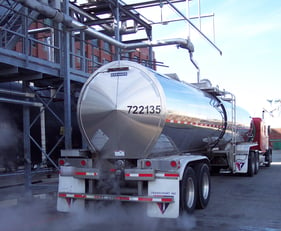State of Freight Overall
- Not enough truck drivers in the market to handle capacity
- Until the driver market increases, we will see capacity crunch.
- Drivers are seeking lanes where amenities are available (parking, showers, …).
- Industries are not able to maintain adequate inventory - lots of spot orders.
- Truck carriers are trying to give assets to their established customers, so new customers are being turned down
Truck

- Smaller carriers are handling more loads, but it's not enough coverage to make up for larger carriers not handling amount of loads they have in the past
- Freight has always been more difficult to secure in the Northeast, but now more than ever
- Rates have increased substantially - customers will be paying more
- Tolls have also increased substantially for trucks.
- Many accessorials have increased, along with FSC, adding to the overall rate increase. Tank cleaning, steaming and driver detention are the ones with the largest increases
- Paying more does not guarantee capacity
- Drivers are dictating more today where they want to go
- Compartment trucks are extremely difficult to secure and carriers not investing in this equipment - it is expensive and has more temperature issues
- Kosher and food grade loads are also extremely difficult to secure. Most kosher & food grade equipment is already in use
- Dedicated is preferred by some carriers, but only if they have trailers. If too much dedicated business is serviced, it removes overall trailers for all customers
- Carriers need to go to certain locations to keep their system in balance
- Texas and Louisiana lanes are easier to cover rather than Georgia, North Carolina & South Carolina - drivers make more money on longer hauls
- CSXT secured Quality, one of the largest carriers in the country, for servicing their yards and this took away capacity to companies
Rail

- Securing available railcars for lease has been more difficult than just as little as six months ago
- Rail rates increase each year, there is very little room for negotiation
- Fuel surcharges (FSCs) have increased each month. CSX has gone from $0.11/mile in January 2021 to $0.33/mile in August 2021
What TRT is doing
- We are in the process of leasing additional railcars
- Asking customers if they can supply their own railcars for pick-up of product
- Identifying any customers that can take rail rather than trucks and converting when we can work it
- Clean railcars coming back from shop are earmarked for a fleet so they are not used carelessly
- Continuing daily Unconfirmed Loads meetings for trucks where we prioritize customers. Salesperson and customer input and cooperation is critical
- Cold calling new carriers for any capacity
- Customers are looking for their own trucks which is showing that customers are starting to get involved in securing their loads
- Keeping terminals stocked with product is key
- Investigating terminal options for lanes/products that make sense and have the biggest impact on easing capacity
- Creating a survey for drivers to complete as they leave TRT to understand their experience and what amenities they would want
- Distributing weekly demurrage reports for our railcars, so we can remind our customers to keep them moving
- Carriers added additional driver training locations. They believe enrollment will increase once bonus unemployment benefits run out. Until new drivers enter the market, there will be a capacity crisis
- Follow-up conference calls with our carriers
- Exploring intermodal rates again for the lanes over 1,000 miles
Topics:
trucking industry,
Freight Imbalance,
railcars,
intermodal

